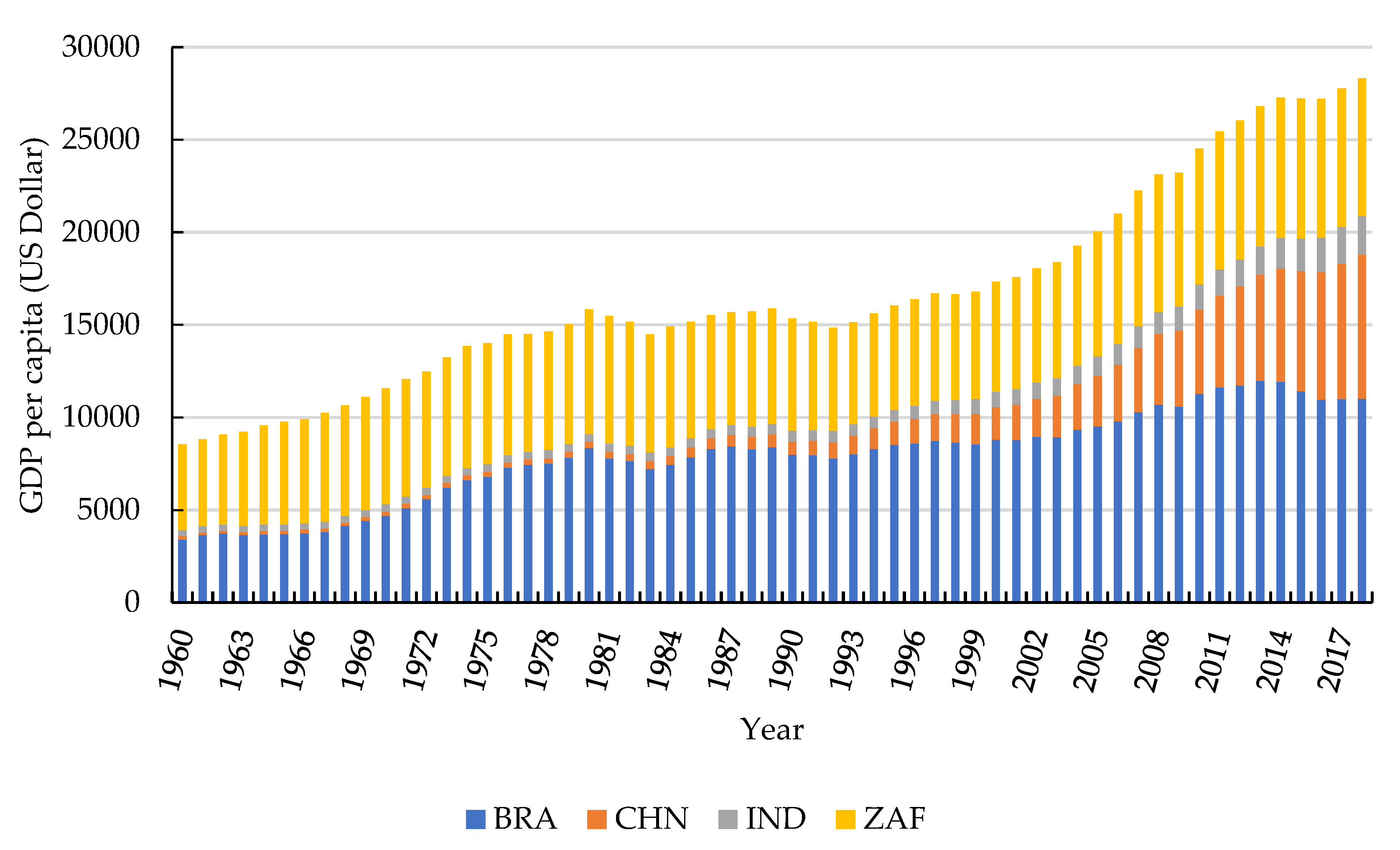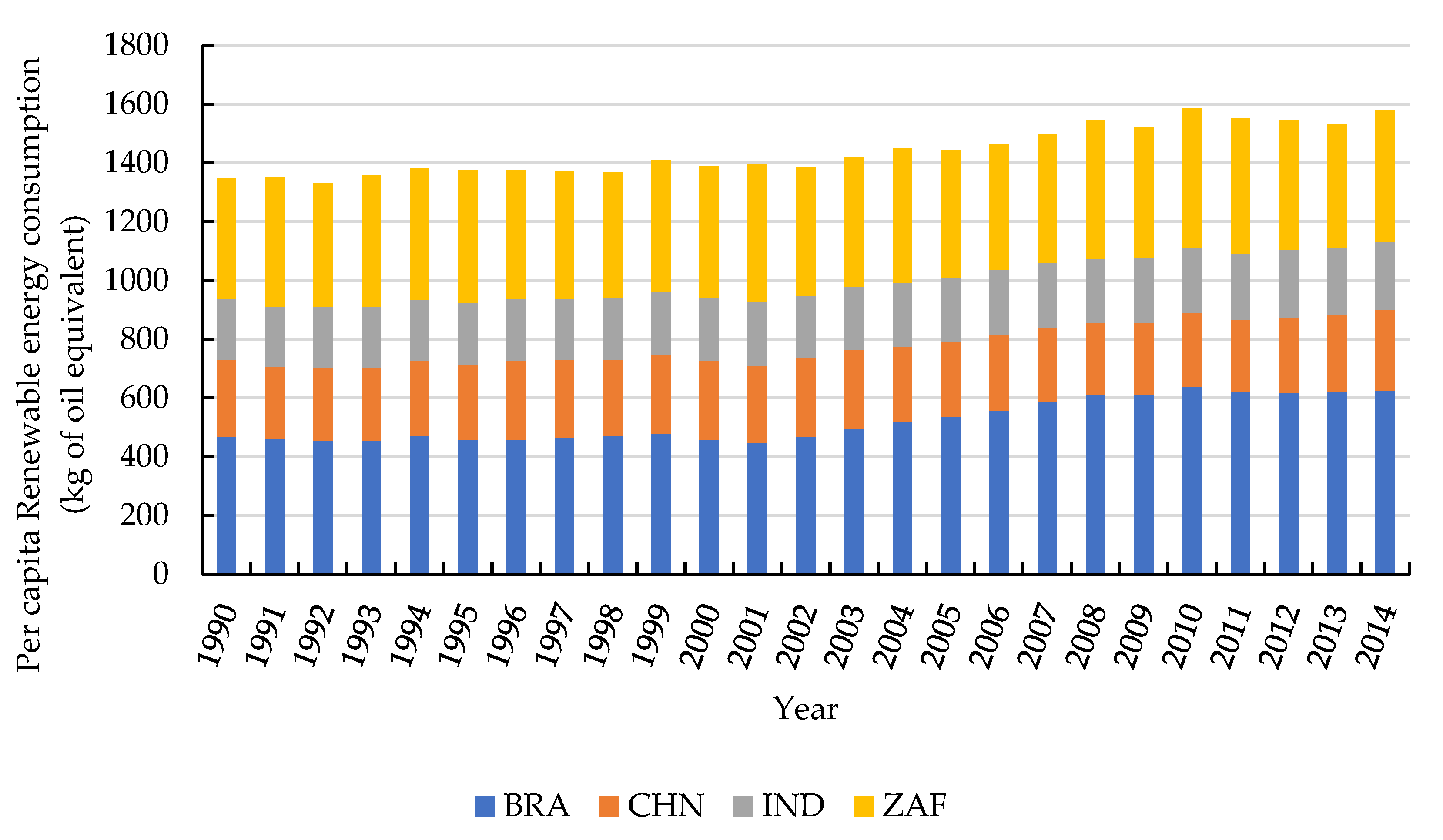1. Introduction
As we all know, global climate change caused by carbon dioxide emissions is endangering the sustainable development of the world, and has become a hot topic in international political, economic, and diplomatic discourse debate [
1]. The rising total CO
2 emissions are not only a threat to the health of the biophysical ecosystem but also has a profound impact on human society. CO
2 emissions, which are closely related to climate change, have always been described as a “super wicked problem” [
2] that has an impact on human welfare. Therefore, how to formulate a policy of economic, energy, social inclusion, and environmental sustainability is a serious challenge for all countries in the world.
With economic globalization, developing countries are staying in the key economic development period. Especially, developing countries must show a rapid pace of economy growth in order to fight against poverty and improve industrial structure and infrastructure. In recent years, the concept of BRICS is becoming more and more popular in public media and academia. As a typical kind of the developing countries, BRICS countries have significant common characteristics, such as large population, underdeveloped economy but rapid growth, and the willingness to embrace the global market [
3]. In the past 60 years, the BRICS economy has become increasingly prosperous [
4]. The research of Goldman Sachs [
5] found that in less than 40 years, the BRICS may play a more and more important role in the world economy than G6 (United States, Japan, Germany, France, Italy, and United Kingdom), and the size of BRICS economies may account for more than half of G6 by 2025. Especially according to the latest research of Pao and Tsai [
6], the gross domestic product (GDP) of BRICS countries is expected to exceed than that of the group of seven (seven developed economies, namely United States, Canada, the United Kingdom, Germany, France, Italy, and Japan) by 2050. More concretely, in 2018, the nominal GDP of BRICS countries was the US
$18.6 trillion, accounting for more than 23% of global output [
7]. As shown in
Figure 1, the GDP per capita of BRICS countries increased from
$2140.98 in 1960 (unchanged in 2010) to
$7081.32 in 2018, with an average annual growth rate of 2.11%. Its contribution to world economic growth should not be underestimated. With the rapid economic growth, the relationship between economic growth and air pollution in BRICS countries is a widely debated issue. Especially BRICS countries’ economic growth and industrialization level rely heavily on high energy-consuming industries such as construction, mining, and manufacturing [
8], which also lead to a sharp rise in CO
2 emissions in BRICS countries. As shown in
Table 1, BRICS countries occupy an important seat in the list of major carbon emitters in the world. In 2014, the CO
2 emissions of the whole BRICS countries accounted for three-eighths of the world’s total, and of the first three seats, BRICs hold two. It can also be seen from
Figure 2 that the per capita CO
2 emissions are also rising rapidly with economic development. The deteriorating environment also makes us aware of the consequent excessive CO
2 emissions, which play a major role in the global greenhouse effect and the world economic development [
9]. During the fifth BRICS summit in 2013, BRICS countries sealed a “multilateral agreement on climate cooperation and the green economy” to ensure the financial support and the technical exchange to cope with the negative effect of climate change on developing countries [
8]. BRICS economies are currently located downstream of the global value chain, which means that their environmental costs are high [
7], and it is unsustainable to sacrifice environmental quality to maintain economic growth [
10].
Under the double challenges of the global climate crisis and economic growth pressure, the concept of low-carbon development and green energy transformation is now essential for the international community [
11]. The main energy used by BRICS countries is fossil energy [
12], and their dependence on fossil energy has provoked alarm about fossil energy limited supply, energy security, and environmental degradation [
13]. The use of fossil energy is identified as a main factor in increasing greenhouse gas emissions, which are the culprit of climate change and global warming [
14]. Renewable energy is considered to be the most effective way to reduce carbon dioxide emissions [
15]. In order to achieve the goal of sustainable development and protect the environment, renewable energy is promoted to replace the fossil energy. Meanwhile, the use of renewable energy will not only increase environmental benefits, but also help economies increase employment and reduce their dependence on foreign resources [
16]. Besides, renewable energy is the fastest-growing energy form. Therefore, as concerns about environmental degradation and energy security grow, the search for and use of renewable energy is considered as a solution for the sustainable development of BRICS countries. The per capita consumption of renewable energy in the BRICS countries has not grown rapidly with the development of the economy, as shown in
Figure 3, so renewable energy has a bright future in the BRICS countries. In 2013, four BRICS countries (China, Brazil, India, and South Africa) were among the top 10 renewable energy investment countries [
17]. Concern has been raised about the social and environmental sustainability in BRICS countries. It is a top priority for BRICS countries to coordinate the relationship between the economy and environment and mitigate the global greenhouse effect, which is of great significance to the global sustainable development [
9,
18].
Given that carbon dioxide emissions and sustainable development are the main concerns of policymakers and energy environmentalists, we will take BRICS countries (except Russia) as the research objects based on the 3SLS model and carry out panel analysis on the relationship between real output, renewable energy consumption, and CO2 emissions. To study the nexus between real output and renewable energy consumption and carbon dioxide emissions, and how to adjust the relationship, we will provide strong suggestions for climate change mitigation policies. In order to study this hot issue, we analyzed the existing literature and adopted appropriate methods. Through unit root test, cointegration test, model setting test, and 3SLS regression estimation we have studied the real output, renewable energy consumption, and CO2 emissions of BRICS countries, providing a reference for global sustainable development.
The main contributions of this paper to the existing research are as follows: (1) Although there is a lot of literature on the relationship between per capita GDP (or real output) and energy consumption, the literature on renewable energy consumption in BRICs countries, for example, is very scarce, and the results are uneven [
19]. As a potential variable, the consumption of renewable energy is added to the relationship between real output and CO
2 emissions. However, the contribution of renewable energy to reducing CO
2 emissions without damaging the actual output is ignored in the literature. As the results of previous studies are not clear, further studies on the relationship between real output, renewable energy consumption, and environmental degradation are needed as different comparative opinions. (2) We study the relationship between real output, energy consumption, and CO
2 emissions through the energy output emission system, rather than using a simple single econometric model to describe the relationship between them. Moreover, simultaneous equation technology can also effectively avoid some econometric problems (such as endogenous problems and residual simultaneous correlation problems). (3) In addition to real output and renewable energy consumption, financial development, human capital level, physical capital, urban population, and trade openness are also included in the research system to overcome regulatory deviation. It is generally believed that taking more factors related to CO
2 emissions into account in the model can ensure the accuracy of the calculation results [
20]. (4) To find out the role of renewable energy consumption in real output and CO
2 emissions is of great significance to the sustainable development of developing countries, especially BRICs countries. It not only helps policy-makers and governments to reduce carbon dioxide emissions, but also promotes the growth of the renewable energy industry.
The rest of the paper is arranged as follows:
Section 2 states a literature review.
Section 3 presents an introduction to the research framework and model. Data description, empirical results, and discussion are described in
Section 4.
Section 5 introduces the conclusions, policy implications, and study limitations.
5. Conclusions
This paper studies the relationship between real output, renewable energy consumption, and CO2 emissions in BRICS countries from 1999 to 2014. Through the energy output emission relationship, a simultaneous equation model is established. On this basis, this paper estimates the simultaneous equation model by three-stage least square method (3SLS) and makes an empirical analysis of the results of the BRICS group and individual countries. The empirical results show that for BRICS, there is a complete ternary relationship between BRICS variables (energy—output—emission), and renewable energy has a significant positive impact on real output, and vice versa. Compared with other countries, this result is particularly significant in Brazil. There is an incomplete link (no output emission relationship) between China and India variables. However, the correlation between variables in South Africa mainly occurs in the energy output chain (renewable energy GDP per capita). In addition, financial development plays a significant role in promoting the development of renewable energy. Financial development can simplify the process of capital accumulation and energy procurement financing, contribute to more investment in renewable energy, and enable BRICS countries to benefit from the transfer of “green technology.”
The results show that the relationship among real output, renewable energy consumption, and CO2 emissions is different in different countries. There are also imbalances in the internal development of BRICS countries, so each country should also adapt its energy policies to local conditions. For India and South Africa, increasing renewable energy consumption can reduce CO2 emissions at the expense of real output. For economies such as India and South Africa in urgent need of development, encouraging renewable energy consumption is not necessarily an effective way to reduce CO2 emissions. How to achieve sustainable development is crucial for South Africa and India. In order to make per capita GDP reach the turning point of Kuznets curve, it is necessary to improve citizen consciousness, industrial structure reform, and human capital level. The increase in income will have higher requirements for environmental quality, which will eventually lead to increased investment in renewable energy in India and South Africa. For China and Brazil, how to achieve low-carbon growth by increasing investment in renewable energy and adjusting energy consumption structure without reducing real output. In addition, the positive role of financial development in promoting renewable energy consumption should not be ignored, so it is suggested that BRICS countries can improve the renewable energy financing network and reduce the financing cost of renewable energy. As a group of developing countries with rapid development, sustainable development is the most important, and environmental pollution is the obstacle to sustainable development. Therefore, effective measures must be taken to adapt to local conditions. Finally, BRICS countries should act together, strengthen cooperation, jointly promote the development of renewable energy and energy conservation and emission reduction technologies, and meet the growing energy demand by finding alternative clean energy.
The relationship between real output, renewable energy consumption, and CO2 emissions of BRICS countries is studied in this paper. This research also has some shortcomings, such as: (1) lack of Russia’s data makes the BRICS sample data incomplete. In future studies, enough data samples can be collected for in-depth analysis. Of course, similar groups of countries can repeat this analysis. (2) Although our research focuses on renewable energy, there are many types of renewable energy that were not covered. In future studies, we can analyze the impact of different types of renewable energy on real output and CO2 emissions.









